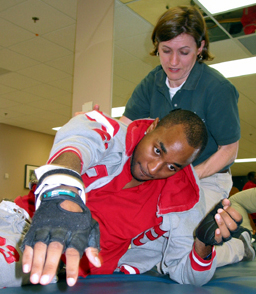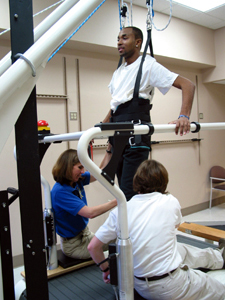JACKSON, Miss.—The day he laced on his first pair of football cleats, Fred Perryman began fantasizing about filling the shoes of NFL stars like Deion Sanders and Champ Bailey.
“I wanted to be the one on Sports Center,” said the Moss Point resident. “I wanted to be the one getting all the attention.” But the Gulf Coast Community College defensive back never wanted this – to have all eyes on him as he lay eerily still in the middle of a football field.
Moments before, Perryman had been playing his heart out in a Sept. 25 grudge match against Jones Community College in Ellisville. But he now lay flat on his back, growing nervous about the foreboding hush of the crowd and the concerned look in his coach’s eyes.
“I remember it was quiet, and the coach kept saying: ‘Can you feel this?’ It dawned on me then that I was paralyzed,” said Perryman, who broke the C-5 and C-6 vertebrae in his neck during a violent collision with a teammate and an opposing player. “The lady in the ambulance said: ‘You can cry.’ But I was more mad than sad. I wanted to win that game.”
Today, that trademark intensity is serving Perryman well as he works with staff at Methodist Rehabilitation Center in Jackson to reclaim every ounce of movement that he can. The energy he once devoted to summer wind sprints on the beach is now being put into a project he calls “Fred Perryman – Part 2.” And this sequel ain’t for sissies.
Perryman left a rehabilitation facility nearer his home because it was “too soft.” He said he prefers therapists who will push him, and he has found that among the experienced staff of Methodist’s spinal cord injury program. To tap into Perryman’s competitive spirit, Methodist physical therapist Cathy Henderson wields a stopwatch while he does laps around the therapy gym in his wheelchair. “I call these time trials,” she said.
On a recent weekday, Perryman took on another challenge – a workout on the hospital’s weight-supporting, treadmill gait-training system. As he dangled from a contraption resembling a parachute harness, two physical therapists “walked” his legs along the moving treadmill.
Henderson said she was inspired to use the system after Perryman discovered he could move his right toes. “If he does get strength back in his legs, this will help train his body in the reciprocal motion of walking,” she explained. “He is able to feel his feet hit now, and it’s good to send those signals to the brain. We’re also doing this to improve his endurance and cardiovascular health. Because it’s weight-bearing, it’s also good for his bone density and it helps keep spasms under control.”
People who suffer a “complete spinal cord injury” involving their C-5 and C-6 vertebrae typically lose the use of muscles in their arms, hands, wrists, chest, abdomen and legs. A plus for Perryman is his injury is considered “incomplete,” which means it’s possible that he could regain function below his injury level.
While Perryman has been encouraged by the return of sensation in his legs, it remains to be seen whether he will realize his dream to walk again. Currently, Perryman has functional movement in his neck, shoulders, biceps and wrists. “We’re showing him how to use the most of what he has,” Henderson said.
Perryman’s athletic background has been an asset in therapy, Henderson said. “He’s aware of his body and he knows what he can push through and what he shouldn’t push through. He also looks to see what he can do better the next day, which is what coaches teach you. He has been a delight to work with because he makes gains every week.”
While Perryman’s determination to always “be better than those around me” keeps him motivated during therapy, he concedes that his gung-ho nature may have been his undoing the night he was injured. “I was real hyped,” he said. “Jones had been beating us for 10 straight years and I wanted to win so we could break that streak.”
Late in the third quarter, Perryman noticed a receiver jumping to the outside and tried to make a quick adjustment. “I had my head down and I was trying to tackle his legs,” Perryman said. In that position, he never saw the teammate who was hurtling his body in the same direction. When they collided, Perryman’s neck bore the brunt of the impact.
According to the latest report from the National Center for Catastrophic Sport Injury Research, nine football players suffered similar cervical spinal cord injuries in 2003. Like Perryman, most were defensive players who were hurt while tackling someone during a game.
Now Perryman wryly notes that he should have played offense. But he refuses to blame his fate on football. He believes the sport that landed him in a wheelchair could have put him on the map. “I could have made it to the draft and made millions,” he said.
Instead, he’s adjusting to a new life that will be defined by the gains he makes in therapy. When Perryman arrived at Methodist, he needed help with every activity – from feeding himself to getting dressed. Now he’s slowly regaining his independence and indulging in pastimes typical of a 21-year-old.
“He has mastered the skills of chip and fry eating,” jokes Stephanie Lynchard, his occupational therapist at Methodist. “You would not know he has problems with his hands to watch him play cards.”
Perryman plans to move back in with his mother and stepfather, Mary and Ron Middleton, as soon as they can find a more wheelchair-accessible home in Moss Point. His ultimate goal is to return to college and finish his business administration degree. He imagines he might open a franchise restaurant someday.
But first he must learn new ways to do things he once took for granted – like tying his shoelaces, typing and signing his name. “One thing he wants to do is to be able to sit in the stands at a basketball game without his wheelchair,” Lynchard said. She has no doubt he’ll achieve it. “He has the ability and the determination to do more.”
Perryman says the rigors of rehab are like “doing three-a-days.” But he’s up for the challenge. “I know how to go the extra mile to get better,” he said. “This is just a long mile.”
A long mile that has been lined with supporters, he adds. Perryman said he has been cheered and encouraged by the family, friends, teammates and coaches who have stayed by his side, the Methodist staff who have “treated me so right” and the many people he has never even met who have contributed to a fund for his expenses. “The last I heard it was at $10,000,” he marvels. “I never knew people loved me like that.”
Tips to avoid football-related cervical spine and brain injuries for players:
- Shoulder block and tackle with the head up.
- Do conditioning exercises to strengthen neck muscles.
- Never use the head or helmet as a battering ram when blocking, tackling and ball carrying. Ball carriers should not lower their heads when making contact with tacklers.
- Make sure all equipment—especially the helmet—is properly fitted.
For football officials and coaches
- Concentrate on helmet-face mask contact and call penalties on players who use improper blocking and tackling techniques.
- Ensure that a physician or someone who is qualified in emergency care is on the field during games or practice.
- Have a written emergency plan that addresses what will happen if a possible catastrophic head or neck injury occurs. Permanent disabilities can be caused if victims are improperly moved or transported after such injuries.
- When a player experiences signs of head trauma – loss of consciousness, visual disturbance, headache, inability to walk correctly, obvious disorientation or memory loss – he should receive immediate medical attention and not be allowed to return to the game or practice.
Source: National Center for Catastrophic Sport Injury Research


